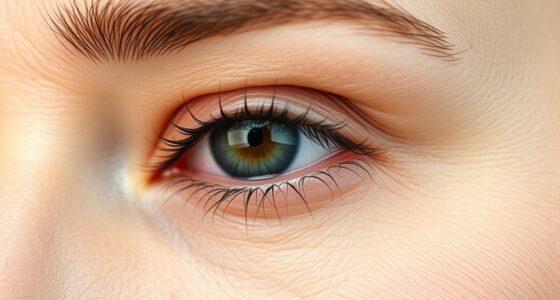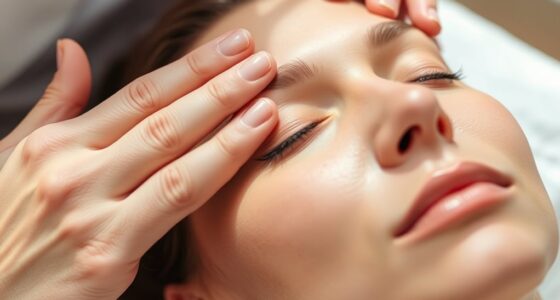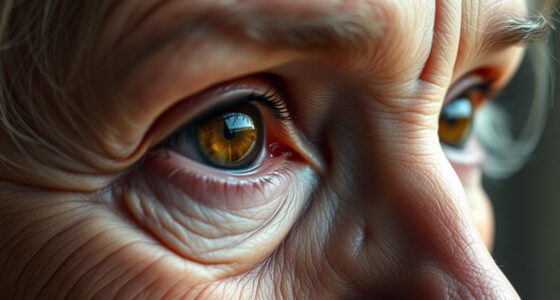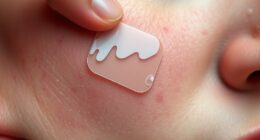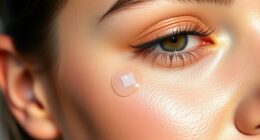Studies show that pollution particles accelerate premature eye aging by causing cellular damage and oxidative stress, which weaken your eye tissues and disrupt the tear film. This leads to dryness, irritation, and increased risk of conditions like cataracts and macular degeneration. Continuous exposure worsens these effects over time. To protect your eyesight, understanding how pollution impacts your eyes is essential—exploring effective strategies can help you better guard against damage and aging.
Key Takeaways
- Scientific studies link high pollution levels with increased oxidative stress in eye tissues, accelerating aging signs.
- Research shows pollutants damage tear film stability, leading to dry eyes and early age-related eye conditions.
- Studies indicate pollution exposure impairs visual functions, including color accuracy and overall clarity.
- Evidence suggests pollutants cause cellular damage in cornea and lens, hastening cataracts and macular degeneration.
- Preventive measures like protective eyewear and artificial tears are recommended by research to mitigate pollution-related eye aging.
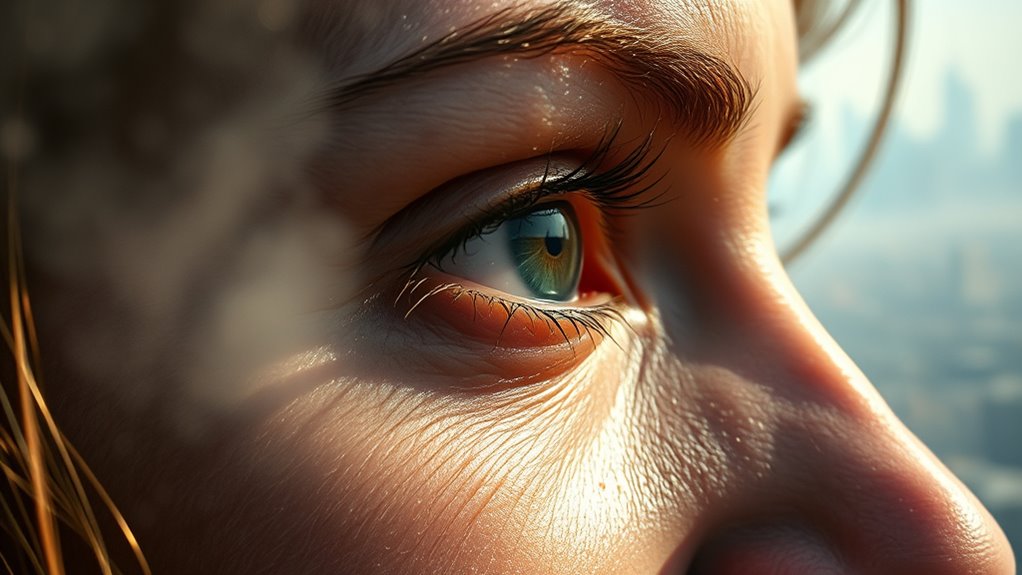
Pollution particles in the air can accelerate the aging process of your eyes, leading to premature signs of damage. When you breathe in polluted air, tiny particles like smog, dust, and chemical fumes enter your eyes, causing irritation and stress to the delicate tissues. Over time, this constant exposure can weaken your eye’s natural defenses, making you more vulnerable to age-related issues such as dryness, cataracts, and even macular degeneration. Scientific studies have shown a direct link between high levels of air pollution and declining eye health, emphasizing how critical it is to protect your eyes from environmental hazards.
Air pollution doesn’t just affect your lungs; it can have a profound impact on your eyes as well. The pollutants can cause oxidative stress, which damages the cells in your cornea and lens. This damage accumulates over the years, speeding up the aging process and reducing your eyes’ ability to repair themselves. You might notice increased irritation, redness, and a gritty feeling in your eyes, especially during days with heavy smog or pollution. These symptoms are often early indicators that your eye health is being compromised by environmental factors beyond your control.
Moreover, pollution particles can penetrate the tear film—the protective layer that keeps your eyes moist—and disrupt its stability. When this happens, your eyes become dry and more prone to inflammation, which can accelerate signs of aging. If you spend a lot of time outdoors in polluted environments, you’re increasing your risk of developing chronic eye conditions that could impair your vision long-term. Studies suggest that people living in urban areas with high pollution levels experience faster deterioration of their eye health compared to those in cleaner environments. Additionally, exposure to pollutants can impair the color accuracy of your eyes, further contributing to visual decline over time.
Protecting your eyes from air pollution involves practical steps. Wearing sunglasses or protective eyewear can shield your eyes from direct contact with airborne particles. Using artificial tears can help maintain moisture and reduce dryness caused by pollutants. Regular eye check-ups are essential to catch early signs of damage before they worsen. Also, staying indoors during days with poor air quality minimizes exposure and helps preserve your eye health. Remember, the longer your eyes are exposed to polluted air, the more likely they are to age prematurely and develop complications.
Frequently Asked Questions
Can Pollution Particles Affect Eye Health Immediately?
Pollution particles can affect your eye health immediately by causing irritation and discomfort. When you’re exposed, particles absorb into the tear film and eye surface, leading to redness, burning, and tearing. You might notice these symptoms right away, especially in polluted environments. Wearing protective eyewear and avoiding direct exposure can help minimize particle absorption and prevent immediate irritation, keeping your eyes healthier in the short term.
Are Certain Age Groups More Vulnerable to Pollution-Related Eye Aging?
You might notice that age-related vulnerability varies, with older adults generally at higher risk of pollution-related eye aging. Genetic factors also play a role, influencing how your eyes respond to pollutants. Younger individuals typically have more resilient eyes, but prolonged exposure can accelerate aging signs. Recognizing these factors helps you take preventive measures, such as protecting your eyes from pollution and maintaining good eye health practices regardless of age.
Do Indoor Pollution Sources Impact Eye Aging as Much as Outdoor?
Think of indoor air as a hidden thief, quietly stealing your youthful clarity. Indoor pollution sources can impact your eye aging just as much as outdoor ones, because pollutants like smoke, dust, and chemicals linger longer inside. You might breathe cleaner air outside, but ignoring indoor pollution sources leaves your eyes vulnerable to premature aging. Stay vigilant—improve ventilation and reduce indoor toxins to protect your vision over time.
Can Protective Eyewear Prevent Pollution-Induced Eye Damage?
You might wonder if protective eyewear can prevent pollution-induced eye damage. Wearing glasses with UV protection and durable materials can shield your eyes from harmful particles, reducing damage caused by environmental pollutants. Make sure your eyewear is designed for outdoor use, offers high material durability, and blocks UV rays. This proactive step helps preserve eye health, preventing premature aging and discomfort from pollution exposure.
What Lifestyle Changes Reduce Risk of Pollution-Related Eye Aging?
Imagine discovering simple lifestyle tweaks that can slow eye aging. You can start by making diet modifications—adding antioxidants like vitamins C and E helps protect your eyes from damage. Managing stress is equally vital, as it reduces inflammation and prevents premature aging. Combining these changes with regular eye protection creates a powerful shield against pollution’s harmful effects, keeping your eyes healthier and younger-looking longer.
Conclusion
As you navigate daily life, remember that pollution particles are like silent thieves stealing your youthful glow, much like time’s relentless march. These invisible intruders can accelerate eye aging, turning your vibrant gaze into a faded reflection. Stay vigilant, protect your eyes, and don’t let the clouds of pollution write a story you’ll regret. By shielding yourself now, you preserve the sparkle in your eyes, keeping your vision bright and youthful, no matter what the future holds.



